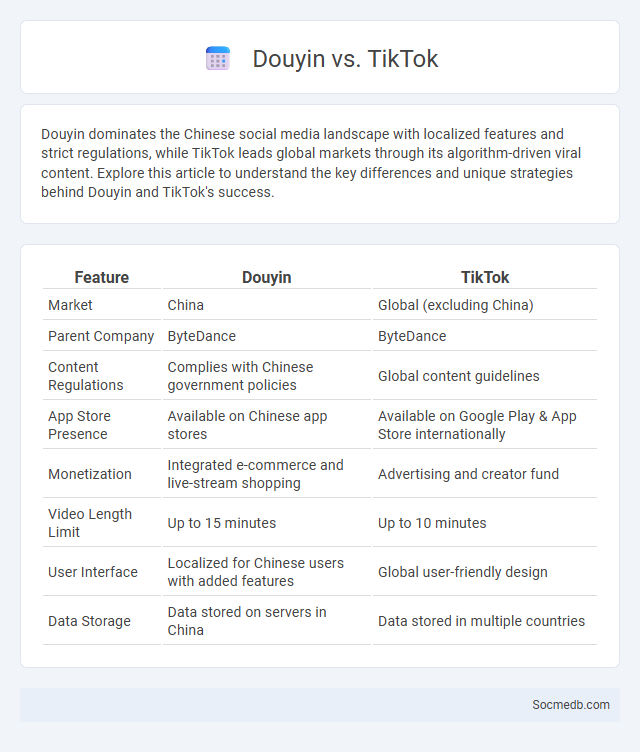
Photo illustration: Douyin vs TikTok
Douyin dominates the Chinese social media landscape with localized features and strict regulations, while TikTok leads global markets through its algorithm-driven viral content. Explore this article to understand the key differences and unique strategies behind Douyin and TikTok's success.
Table of Comparison
| Feature | Douyin | TikTok |
|---|---|---|
| Market | China | Global (excluding China) |
| Parent Company | ByteDance | ByteDance |
| Content Regulations | Complies with Chinese government policies | Global content guidelines |
| App Store Presence | Available on Chinese app stores | Available on Google Play & App Store internationally |
| Monetization | Integrated e-commerce and live-stream shopping | Advertising and creator fund |
| Video Length Limit | Up to 15 minutes | Up to 10 minutes |
| User Interface | Localized for Chinese users with added features | Global user-friendly design |
| Data Storage | Data stored on servers in China | Data stored in multiple countries |
Introduction: The Rise of Short-Form Video Platforms
Short-form video platforms like TikTok, Instagram Reels, and YouTube Shorts have revolutionized social media by delivering quick, engaging content that captures users' attention within seconds. These platforms leverage advanced algorithms and mobile-friendly formats to create a dynamic user experience, driving increased video consumption and content creation worldwide. The rise of short-form videos has reshaped digital marketing, influencing trends, brand strategies, and user engagement across global audiences.
Douyin vs TikTok: Understanding the Key Differences
Douyin and TikTok, though owned by the same parent company ByteDance, operate as separate platforms catering to different markets with unique regulatory environments and cultural nuances. Douyin is exclusively available in China, featuring localized content regulations and integrated e-commerce functions tailored for Chinese users, whereas TikTok serves a global audience with a broader content diversity and varied monetization strategies. Understanding these key differences can help You leverage the strengths of each app for targeted social media marketing and content creation strategies.
Global vs Domestic: Market Reach and Audience Demographics
Social media platforms vary significantly in global versus domestic market reach, with global networks like Facebook and Instagram offering access to millions of users worldwide, ideal for brands targeting diverse, international demographics. Domestic social media channels, such as China's Weibo or Russia's VKontakte, provide concentrated access to local audiences with specific cultural and linguistic preferences, which can enhance localized marketing strategies. Understanding your target audience's location and behavioral patterns on these platforms enables Your brand to optimize engagement and tailor content for maximum impact.
Viral Content Trends: What Goes Viral on Each Platform
Viral content trends vary significantly across social media platforms, with TikTok favoring short, catchy videos featuring popular music and hashtags, while Instagram thrives on visually striking images and Reels that emphasize authenticity and behind-the-scenes moments. Twitter captures viral moments through witty, concise text and real-time reactions to breaking news or trending topics, whereas YouTube excels with longer, engaging videos that include tutorials, challenges, and reaction content. Understanding these platform-specific preferences allows Your content to resonate more deeply, increasing the likelihood of going viral.
Algorithm Mechanics: How Douyin and TikTok Promote Virality
Douyin and TikTok utilize advanced machine learning algorithms that analyze user interactions such as likes, shares, comments, and watch time to tailor personalized content feeds, maximizing engagement and content virality. Their recommendation systems prioritize new and diverse videos with high initial engagement rates, pushing them to broader audiences rapidly. By continuously learning from user behavior and content performance, these platforms maintain an ever-evolving feed that amplifies viral trends and creators' reach.
Content Creation Tools: Features and Editing Capabilities
Content creation tools on social media platforms offer advanced features such as AI-driven filters, customizable templates, and real-time collaboration, enabling users to produce professional-quality posts efficiently. These tools support various media formats, including images, videos, and reels, with editing capabilities like cropping, color correction, and animated text overlays. By leveraging these functionalities, your social media presence can be enhanced through visually engaging and highly shareable content.
Monetization and Influencer Opportunities
Social media platforms offer extensive monetization opportunities through brand partnerships, sponsored content, and affiliate marketing, enabling influencers to generate significant income. Influencers can leverage their engaged audiences to promote products, secure exclusive deals, and participate in platform-specific monetization features like Instagram Shopping or TikTok Creator Fund. Maximizing your influence involves creating authentic content that drives engagement and attracts lucrative collaborations.
Cultural Influences on Viral Success
Cultural influences play a crucial role in shaping social media content that resonates widely, as viral success often hinges on how well a post aligns with the values, humor, and norms of a specific community or demographic. Your content's ability to tap into culturally relevant trends, languages, and symbols can significantly boost engagement and sharing behaviors. Understanding these cultural nuances allows you to create more relatable and impactful messages, increasing the odds of widespread viral reach.
Privacy, Censorship, and Regulatory Challenges
Social media platforms face significant privacy concerns as they collect vast amounts of personal data, raising risks of misuse and unauthorized access. Censorship issues arise when content is selectively controlled or suppressed, impacting freedom of expression and user trust. Regulatory challenges intensify as governments worldwide impose stricter rules to balance platform accountability with users' rights, requiring you to stay informed about evolving policies affecting your online interactions.
Future Prospects: Evolution of Viral Video Platforms
Viral video platforms are poised to revolutionize content consumption through advancements in AI-driven personalization and immersive technologies like augmented reality (AR) and virtual reality (VR). Emerging algorithms will further optimize video recommendations, increasing viewer engagement and facilitating rapid content discovery. Your ability to leverage these evolving platforms can amplify reach and influence in the dynamic social media landscape.
 socmedb.com
socmedb.com